
Sorrento is a town overlooking the Bay of Naples in Southern Italy. A popular tourist destination, Sorrento is located on the Sorrentine Peninsula at the south-eastern terminus of the Circumvesuviana rail line, within easy access from Naples and Pompei. The town is widely known for its small ceramics, lacework and marquetry (woodwork) shops.

Valle San Giovanni is a small village in the province of Teramo, in the Abruzzo region of central Italy. It is a frazione of the town of Teramo.
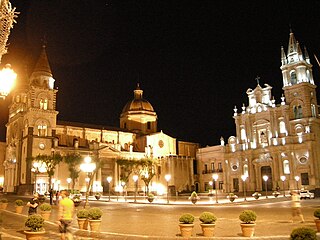
Acireale is a coastal city and comune in the north-east of the Metropolitan City of Catania, Sicily, southern Italy, at the foot of Mount Etna, on the coast facing the Ionian Sea. It is home to numerous churches, including the Neo-Gothic St. Pietro's Basilica, St. Sebastiano's Basilica in the Sicilian Baroque style, and the 17th century Acireale Cathedral, and a seminary, for the training of priests. Acireale is also noted for its art and paintings: the oldest academy in Sicily, the Accademia di scienze, lettere e belle arti degli Zelanti e dei Dafnici, is located here.

Nocera Inferiore is a town and comune in the province of Salerno, in Campania in southern Italy. It lies west of Nocera Superiore, at the foot of Monte Albino, some 20 km east-southeast of Naples by rail.

Sessa Aurunca is a town and comune in the province of Caserta, Campania, southern Italy. It is located on the south west slope of the extinct volcano of Roccamonfina, 40 kilometres (25 mi) by rail west north west of Caserta and 30 kilometres (19 mi) east of Formia.

Pacentro is a comune of 1,279 inhabitants of the province of L'Aquila in Abruzzo, Italy. It is a well-preserved historic medieval village located in central Italy, several kilometers from the City of Sulmona about 170 kilometres (110 mi) east of Rome. It is a member of the I Borghi più belli d'Italia association.

Zagarolo is a town and comune in the Metropolitan City of Rome, in the region of Lazio of central Italy. It lies 34 kilometres (21 mi) southeast of Rome, and it borders the municipalities of Colonna, Gallicano nel Lazio, Monte Compatri, Palestrina, Rome, San Cesareo.

Ausonia is a town and comune in southern Lazio, central Italy. It takes its name from the Ausones/Aurunci, whose ancient town Ausona, located nearby, was destroyed by the Romans in 314 BC. In the Middle Ages it was known as Fratte.

Archi is a town and comune in the province of Chieti, Abruzzo, southern Italy. It is part of the Valsangro mountain community.
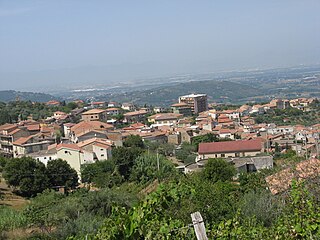
Albanella is a town and comune in the province of Salerno in the Campania region of south-western Italy. It is located 51 kilometers from the city of Salerno.

Magliano Vetere is a town and comune in the province of Salerno in the Campania region of south-western Italy. As of 2011 its population was 739.
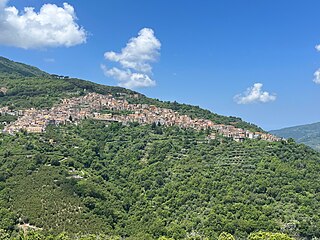
Ucria is a comune (municipality) in the Metropolitan City of Messina in the Italian region Sicily, located about 130 kilometres (81 mi) east of Palermo and about 60 kilometres (37 mi) west of Messina. It is part of the Parco dei Nebrodi.
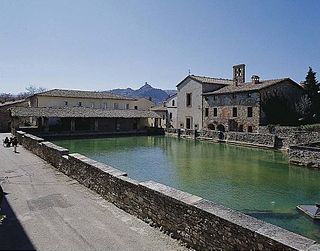
Bagno Vignoni is an Italian village and hamlet (frazione) of San Quirico d'Orcia, situated on a hill above the Val d'Orcia in Tuscany. It is a popular tourist destination and well known for its hot springs.
Cemmo, is a frazione of Capo di Ponte, located right of river Oglio, beneath the Concarena.

Magliano Nuovo is a southern Italian village and hamlet (frazione) of Magliano Vetere, a municipality in the province of Salerno, Campania. As of 2011, its population was 334.
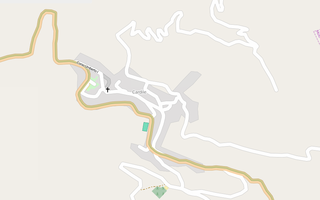
Cardile is a southern Italian village and the only hamlet (frazione) of Gioi, a municipality in the province of Salerno, Campania. As of 2009 its population was of 614.

Piano Vetrale, also shortened as Vetrale or Piano, is a southern Italian village and hamlet (frazione) of Orria, a municipality in the province of Salerno, Campania. As of 2011, its population was of 475.

Chiesa di Santa Maria in Valle Porclaneta is a Romanesque church in Rosciolo dei Marsi, in western Abruzzo, central Italy.

Assergi is a frazione of the comune of L'Aquila, located about 11 km (6.8 mi) from the capital. With a population of just over 500, it is situated at an altitude of approximately 1,000 meters, below the western slope of the Gran Sasso in a small plain called the Piana di Assergi (Plain of Assergi). Assergi was formerly included in the comune of Camarda, which is directly to its south.
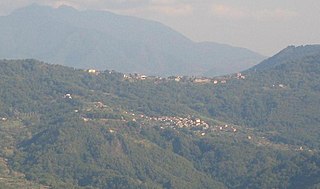
Gorga, also known as Gorga Cilento, is a southern Italian village and the only hamlet (frazione) of Stio, a municipality in the province of Salerno, Campania. As of 2016, its population was 160.



























